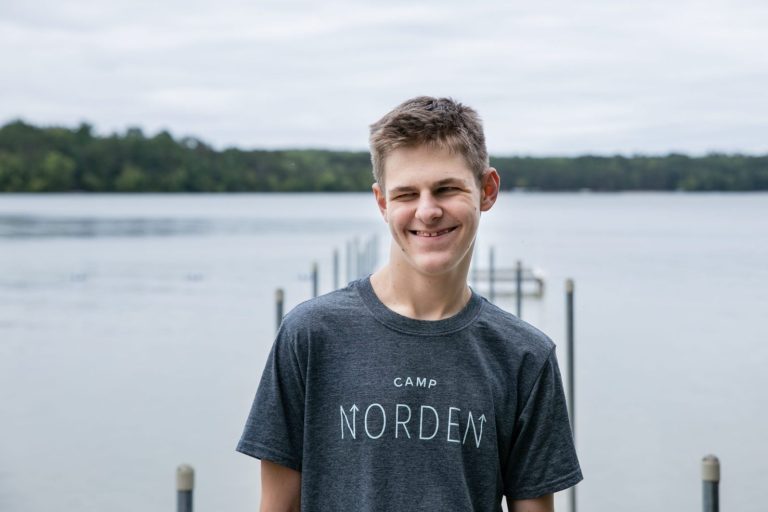Jacob was born with Down syndrome. Individuals with Down syndrome are up to 20 times more likely to develop leukemia than the general population, according to Dr. Julie Ross, University of Minnesota researcher and Children’s Cancer Research Fund co-chief medical advisor. Leukemia peaks with newborns and again between 3 and 6 years of age. Jacob was 4 when he was diagnosed with Acute Lymphoblastic Leukemia (ALL).
Jacob’s journey with ALL began In February, 2008. After watching her son become more and more listless, Jacob’s mother, Julie, took him to an Urgent Care, where the doctor diagnosed an ear infection. “I was not 100 percent convinced it was an ear infection, as our clinic does not have a small-enough otoscope to get into Jacob’s small ear canals,” says Julie.
Two days after Jacob finished his antibiotics, his symptoms returned. He was listless, running a fever, crying and irritable, and he had no appetite. Another ten days of antibiotics didn’t help, and now he had new symptoms – night sweats and a pin prick-like rash. Julie searched the Internet for “night sweats” and found two references: influenza and leukemia. The rash pointed to leukemia. In the morning, she asked Jacob’s doctor to run a full blood count. “Boy, was the doctor surprised when the blood work came back abnormal,” she says. “We were immediately admitted to University of Minnesota Children’s Hospital in Minneapolis.” That was March 24, 2008.
“The reality didn’t hit me until about a week later,” says Julie, “when I was sitting with Jacob in an infusion room while he was receiving chemotherapy. The fog suddenly lifted, and I realized that my baby had cancer. It may sound strange, but in a way I was relieved. I knew ALL had a very high cure rate, and I knew we had a plan to attack it. I couldn’t wait to get going with the treatment.”
Jacob’s treatment first consisted of intense chemotherapy, which put him in remission just one month after his diagnosis. This was followed by five months of chemotherapy in varying levels of intensity before he began his maintenance phase. During the 33 months of maintenance, Jacob is receiving daily oral chemotherapy, monthly IV chemotherapy and quarterly lumbar chemotherapy. He has been treated by Susan Kearney, M.D., and Michael Burke, M.D., both pediatric hematologist-oncologists at the University of Minnesota.
During the first six months of treatment, Jacob was instructed to remain at home to avoid infections and illnesses. Because he was content at home, the restricted lifestyle did not impact Julie and her family much. “Cancer didn’t change our physical lives that much,” she says, “but it changed our lives emotionally. Every day I was scared that Jacob would be taken from me. I never cried like that before.”
Yet, Jacob had an easier time than many children. He needed fewer blood transfusions than doctors predicted, and the chemotherapy didn’t cause much nausea. He was in the hospital only once in the first six months, when he contracted a staph infection when his blood counts were low. “He was a rock star,” says Julie.
While he could not articulate how he felt, Jacob let his mother know when he wasn’t feeling well. “He would suck his thumb and lean on me,” she says. “That’s how I knew he needed to be held and rocked.”
“Unlike most other children with cancer, Jacob does not dread visits to the hospital,” says Julie. “He actually gets excited. He lives in the moment and has no worries or cares. This helps me live in the moment, too.”
Jacob will be finished with treatment in June, 2011, after which he will need only monthly check-ups to watch for cancer markers. Everyone is looking forward to that day, yet Julie admits to being nervous about when the chemotherapy ends. “I’m scared to death to stop what is keeping the cancer away,” she says. “I don’t want him to have to go through this again.”
Julie and her husband, Mike, also have a daughter, Olivia, who was eight at the time of Jacob’s diagnosis. “The most difficult part of this journey has been juggling our schedules to make sure Olivia’s life does not change much,” says Julie. “With a child who has Down syndrome, we always worry that Olivia feels she is on the back burner. We try very hard to treat our children equally.”
As Julie reflects on the journey that Jacob and their family has been through, she says, “When Jacob entered our world seven years ago, we learned so much about Jacob – how his mind worked. However, when the cancer entered into the scene we learned so much more – how the body worked.” Due to a different genetic make-up, children with Down syndrome who develop leukemia receive a modified treatment protocol than other children diagnosed with leukemia. Patients with Down syndrome are prone to greater toxicity so they will receive less intensive therapy in the next generation of ALL clinical trials opening this year and next, according to Dr. Burke.
When Jacob gets older, Julie intends to read to him from her CaringBridge journal entries. She says, “I want him and everyone out there to know what an amazing little fighter he is!!” When she found out that Jacob’s blood type was B+, she took that as an encouraging sign. “If I ever get a tattoo,” she laughs, “it’s going to say ‘Be Positive!’”



